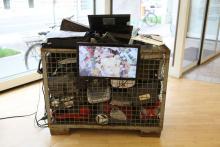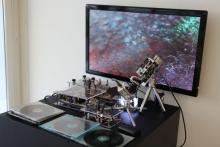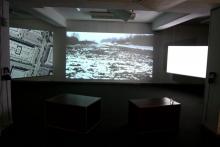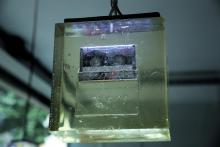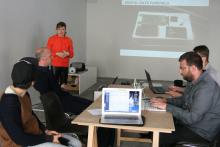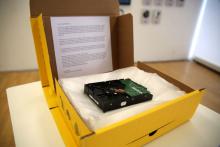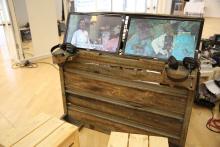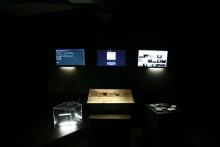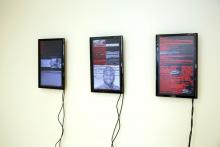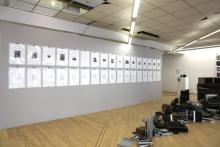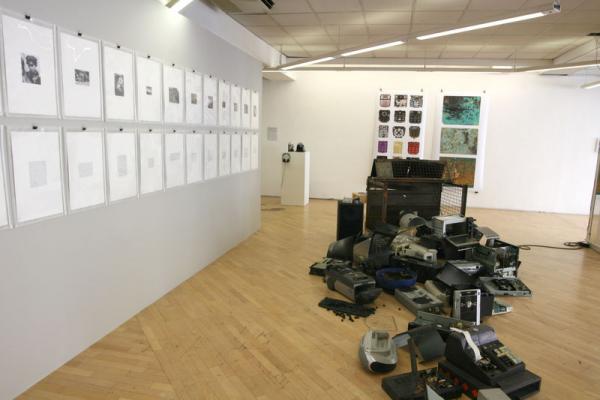
Ground floor:
Bodies of planned obsolescence
von Shu Lea Cheang
As part of the London based Body of Planned Obsolescence project, I travelled to the e-waste processing sites in Lagos and Hong Kong in Spring 2015. Sheltering behind Lagos’ Alaba market, the e-waste dumpsite ILETRONIS is a landscape fictionalized - cows fed on the e-waste roam the hills, heads transport loads of heavy metal, weight scale hung aloft, boys, young men, elders, dealers, buyers, sellers engage with each other – pounding, knocking, hammering, sorting, weighing, Naira exchange hands. The ‘un’natural resources “imported” from developed countries seem to be inexhaustible. Make and unmake, the technology chases its own tails. Print and unprint, the broken circuits fail the promises. At Hong Kong’s Vannex International Ltd, the e-waste is further categorized and distributed. A-Ming’s fast hands un-screw the discarded laptops, each part separated is reused - CPB, fan, harddrive++. This intense work of labor is an act of ultimate salvation.
Wildcat Hauling
von FICTILIS (Andrea Steves und Timothy Furstnau)
Wildcat Hauling is an ongoing project which takes place in the streets of West Oakland, California. Drawing on our respective backgrounds – 12 years as a junk hauler, and 6 years working on global e-waste and sustainability issues – FICTILIS began responding to illegal dumping in the neighborhood where we live and work in 2012, recruiting local junk haulers to join us in conducting coordinated pickups of illegal dumping sites.
Because illegal dumping is a highly visible deviation from standard waste flows, where materials are usually hidden, handled only by mechanized equipment or specialized personnel and contained during transport and processing in inaccessible places, dumping represents a unique opportunity to get broader social and environmental issues out into the open. In addition to removing garbage, Wildcat Hauling volunteers document the process and perform various interventions designed to encourage consideration of these broader issues.
I know where your cat lives
von Owen Mundy
I Know Where Your Cat Lives is a data experiment that visualizes a sample of 1 million public pics of cats on a world map, locating them by the latitude and longitude coordinates embedded in their metadata. The cats were accessed via publicly available APIs provided by popular photo sharing websites. The photos were then run through various clustering algorithms using a supercomputer at Florida State University in order to represent the enormity of the data source.
This project explores two uses of the internet: the sociable and humorous appreciation of domesticated felines, and the status quo of personal data usage by startups and international megacorps who are riding the wave of decreased privacy for all. This website doesn't visualize all of the cats on the net, only the ones that allow you to track where their owners have been.
Forensic Fantasies
von KairUs (Linda Kronman und Andreas Zingerle)
Forensic fantasies is a series of three artworks dealing with data breaches of private information. In the artworks we use data that was recovered from hard-drives that were dumped in Agbogbloshie, Ghana. Reports suggest, that at this e-waste dump, criminals extract data from hard-drives to demand payments from their pre-owners or to resell the information.
#1: Not a Blackmail
The first artwork of the series examines the possibility to blackmail a prior owner of a hard-drive. Besides finding sensitive data of the owner it is crucial to be able to contact the person to express ones demands. From one hard-drive we could find out who it had belonged to, further through social media platforms, we found his current employer and other contact details. Rather than blackmailing the person we grew curious if we could get in contact with this person. Therefore the artwork consists of one ready to be posted package, containing the recovered data and a letter to the pre-owner.
#2: Identity theft
The second artwork of the series focuses on the phenomena of romance scamming. Scammers conduct identity theft by copying bulks of images of attractive people to create fraudulent profiles on social media platforms or dating channels. The scammers pose to be in love with their victim and after gaining their trust they lure them to give gifts and money, always hiding behind their false identity. One of the hard-drives contained several images of attractive ladies. We suspect that the images were copied to this hard-drive to create and sustain fraudulent profiles. West African Nollywood films (mainly Nigerian and Ghanaian low-budget films) have their own way of dealing with the phenomena of scamming, which is a recognised problem in these countries. In this artwork 18 of the fraudulent online profiles using the same images found on the hard-drive are combined with Nollywood found footage clips that thematises the topic of romance scams.
#3: Found footage stalkers
The third artwork of the series takes a closer look at images found on one of the hard-drives. Scanning through the private photos enables very personal insights into the life and habits of the pre-owners of this hard-drive. Through the years we follow them to parties with friends, trips to amusement parks and christmas celebrations with the family. It is a similar to the feeling of stalking someone unknown online, despite the rather uninteresting photo material, one starts to create a story and attach a personality to these fragmented digital representations. By presenting the photos in an album we approach the material as 'found footage', the practice of gathering material from thrift shops, yard sales and flea markets for remixing and creating new artworks, something artist have done for generations. Hence the artwork confronts earlier practices of using 'found footage' with now digital materials found amongst our trash.
Transposon
von Simon Krenn und Matthias Urban
The works of this series deal with the exploration of the representability of imperceptible signals and data streams that have become omnipresent in our culture. Electromagnetic field sensors were used to detect magnetic fields and interferences that were induced by various components of the hard disk drives that were provided by Andreas and Linda at the ‘Behind the smart world’ artlab in Linz. By using an old Edison phonograph the sonified electromagnetic fields were transcribed onto the surface of a wax cylinder. The use of wax as a data/sound carrier leads to the permanent transformation and structural change of the recorded data. Leaving the transcribed information in a transformable and highly indeterminable state.
Shopimation
von Fabian Kühfuß
When I looked into the first restored hard-drive, I will call it “0020” for now, I realised that there was no longer a structure (no folder structure but also no filenames). I decided to build up a new, subjective, structure over there stored data. It became apparent that a lot of thumbnails have been stored on the hard-drive “0020”. Those thumbnails are placeholders for larger images which itself are placeholders for objects, places, people or situations. This makes them, the thumbnails, as a placeholder of a placeholder. A placeholder for real or fictional remembrance, for wishes and dreams or for a secret. There is a huge amount of thumbnails from commercial products at “0020”. For me these commercial thumbnails are placeholders for the aesthetical reflection of the “original owner” about him-/herself. Shopimation is an approach to get closer to an unknown individual by researching his or her “aesthetic dreams”, represented by fashion products, represented again by product photos which are also be represented by thumbnails. As the techno-imagination of Vilém Flusser is an approach of coding a function of the meaning of techno-pictures, Shopimation uses those thumbnails to build up a subjective code of an aesthetic. Built by the remaining data of an unknown person and the re-arrangement by the artist Shopimation could be a code to translate the very private dream of who she/he would like to be. The short animation video is combining the “shopping dreams” with his/her music library. So we get also an idea of how he/she is hearing the world.
Recycling Yantra
von Raphael Perret
Raphael Perret presents photographs and videos about the informal recycling of electronic waste in Delhi, India. Illegally imported, as well as Indian e-waste is there being dismantled and traded in a fascinating network. The colourfulness and aesthetic quality of the images collide with our knowledge about the toxicity of the documented procedures. For the beholder, the familiar shiny surfaces of electronic products are complemented with an idea of what may happen with them in their afterlife.
Over the course of several visits, a series of works developed, allowing various approaches to the topic. The search for an aesthetic of technological disintegration makes visible, what’s unaccessible to our immediate perception. The seemingly far away Indian workers move closer and a story about valuable resources, poison and the exploitation of poverty unfolds.
The publication 'Machines of Desire', documents the project in a multidisciplinary and multicultural manner.
Shell performance
von Martin Reiche
Shell Performance is an open-source software art installation that transforms an operating system into a performative space. The performance is fueled and heavily influenced by the data that is available on all attached or internal storage devices, so that no performance on two different machines is identical to the other. The underlying software, a Linux shell script, is made available to the public via github (https://github.com/studiomrb) on the day of the opening of the exhibition.
In the exhibition setup, Shell Performance is running on the data retrieved from a hard drive that has been collected on an e-waste dump in Ghana by the art collective KairUs in 2014.
Shell Performance questions integrity of data as much as issues of privacy and simulates a digital “game” being played by the software with the data on the device, highlighting the questionable relationship we have with data and our urge to save everything to protect us from potential losses through malfunctions, which on the other hand leads to our data being accessible by third parties around the globe. Shell Performance is understood as an artwork and not as code, therefore it is released under CC-BY-SA-4.0 license.
Goodnight Sweetheart
von Audrey Samson
Have you ever thought of erasing your entire digital footprint? All those selfies, archived emails, tweets, likes, checkins, late night chat sessions…We never really know what to do with our old storage devices, hard drives, old phones full of our secrets, and sometimes, secrets that we have forgotten about ourselves, or at least forgotten their imprint. Because we are afraid of letting them go, because we are not sure we want to get rid of them, because we wonder what will happen to them, who would find them, and what would they do with them…we do not know whether or not our anxieties are justified, but we still have them.Goodnight Sweetheart is a data and device embalming service presented as a participatory installation where visitors are invited to rid themselves of data through a digital data funeral for digital footprints and identities. Defunct devices cast in liquid plastic cubes hang from the ceiling, forming a cemetery of crystalised memories. Memories are embalmed with resin, the data forever preserved.
Bilder einer Ausstellung
von Wolfgang Spahn
The core of the installation Bilder einer Ausstellung (Pictures of an Exhibition) by Wolfgang Spahn consists of re-processing old data repositories, so that broken DVDs are transformed into an audiovisual installation.
A hundred years ago the Italian Futurist Luigi Russolo presented his Intonarumori, and the Bauhaus artist Lásló Moholy-Nagy built his light-space modulator. The first machine generated noises, and the second moved patterns of light and shadow. Both aspects are essential components of the installation Bilder einer Ausstellung (Pictures of an Exhibition). A lab-like setting serves as a generator for both – abstract projections and the corresponding noises. In contrast to Modest Mussorgsky’s composition “Pictures at an Exhibition”, here the sound is recorded directly from the image. The “image slices” consist of transparent miniature images on discarded DVDs. The layer of the optically stored data is treated here with various chemical and magnetic procedures, such as ferrofluid and shellac, after which a laser probes the rotating image. The light beam is then transformed into an electrical signal, which is modulated by an electrical circuit – based on an analog 808 drum machine. A Raspberry Pi camera with a micro lens films and enlarges the abstract image and projects it through a pinhole camera installation. All the procedures and devices use open hardware and software and are documented on the artist’s website.
The Italian Job
von Emilio Vavarella
The Italian Job is a series of conceptual artworks (“jobs”) that intends to highlight the hidden structures behind themes such as originality, legality, artistic legitimization, collective processes, digital labor and the relationship between artists and curators in the age of the Internet. The title is an homage to the Italian Theory, which is a political philosophy rooted in collective processes and theoretical practice.
The second work in the The Italian Job series is entitled An-Archiving Game and began within the National Stolen Art File (NSAF) FBI Archive of stolen artifacts: a digital repository of stolen art created by the US government intelligence agency. Together with curators Bosaro and Stanisic (whose curatorial texts are an integral part of the artwork) I created an exhibition based on copies of stolen photographs. These original copies were sold using an experimental platform called OpenBazaar: an open source project to create an online decentralized network for peer to peer commerce that has no fees, no intermediaries, uses BitCoins and cannot be censored.
HEADCRASH
von Michael Wirthig
The most interesting thing of these hard drives is the magnetic disc itself. It is the physical place where all kind of personal data is saved on. In former works I made various studies about the relationship between inner and outer world. I dissected the hidden world of a number of different appliances to turn them inside out, e.g. I disassembled objects, machines und herbal structures. I extracted the discs of 2 Ghana drives and explored the surface with a microscope. Therefore I made about 1500 photos of the inside and outside influences of the discs, like itches, scratches or dust. The result is a 2 minute tour the force about the inner world of these Ghana drives.
Research team “Times of Waste“
The interdisciplinary research team consists of a core team of six people ranging from visual anthropology, environmental studies, art theory, scenography to music and programming: Flavia Caviezel (lead), Mirjam Bürgin, Anselm Caminada, Adrian Demleitner, Marion Mertens, Yvonne Volkart, associated: Andreas Simon. Most of the team members have been collaborating since “RhyCycling. Aesthetics of Sustainability in the Basel Border Area”, 2010- 2013; “Times of Waste” runs from 2015-2017. Both projects are situated at the Institute of Experimental Design and Media Cultures at the Academy of Art and Design of the University of Applied Sciences and Arts Northwestern Switzerland.
Basement:
Location
von Joakim Blattmann
The composition is based solely on a selection of audio and video files found on the Ghana-hardrives. A few seconds of samples from each file have been heavily altered, so that the original content of each file is unrecognisable. This have been achieved using various outboard electronics and software. Some of the material is also manipulated recordings of the physical disks themselves done with contact microphones and an electromagnetic coil. The work will be presented as a sound installation with 4 to 8 speakers depending on the exhibition space and the positioning of the work.
DEL?No, wait!REW
von Michaela Lakova
DEL?No, wait!REW is an automatized system, which recovers files from hard-drives without the consent or the knowledge of the previous owners, who presume their content has been forever deleted. DEL?No, wait!REW asks is it possible to delete information in the digital age? Whether our storage devices are locally present (hard drives) or dislocated (the cloud), can we ever be certain our data has been permanently deleted? In an ongoing conversation around the impossibility of erasing digital traces, what role do we take? Are we plunderers, interpreters or mediators? The installation aims to prompt the viewers with a decision or ethical choice whether to delete a recovered file or save it by publishing it online. This version of the installation DEL?No, wait!REW uses data from drives purchased at Agbogbloshie e-waste dump in Ghana.
Center of Doubt
von Ivar Veermäe
Center of Doubt is a long-term artistic research project. The aim of the project is to explore and visualise the disappearance and reappearance of network technology, its infrastructure and representation. Center of Doubt is a collection of visual traces depicting the data industry of our times.
Two different approaches provide insight into the complicated and somehow opaque nature of the topic of data centres and (tele)communication technologies: on the one hand, it is an investigation about the materiality and the local circumstances of the infrastructure; while, on the other hand an attempt to offer an alternative visual representation on the issues connected to information technology, which are mainly presented as “cloudy” rhetoric and visuals in advertisement; science-fiction images; or overdriven military language.
The appearance of the commercial 'cloud computing', or more precisely the data centres and their supporting infrastructure, is depicted as a turning point of a new era of centralized internet: big corporations are in a competition to gain a fundamental status for their software and hardware, acting as a basic informational layer.

